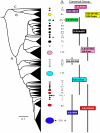Global genetic population structure of Bacillus anthracis
- PMID: 17520020
- PMCID: PMC1866244
- DOI: 10.1371/journal.pone.0000461
Global genetic population structure of Bacillus anthracis
Abstract
Anthrax, caused by the bacterium Bacillus anthracis, is a disease of historical and current importance that is found throughout the world. The basis of its historical transmission is anecdotal and its true global population structure has remained largely cryptic. Seven diverse B. anthracis strains were whole-genome sequenced to identify rare single nucleotide polymorphisms (SNPs), followed by phylogenetic reconstruction of these characters onto an evolutionary model. This analysis identified SNPs that define the major clonal lineages within the species. These SNPs, in concert with 15 variable number tandem repeat (VNTR) markers, were used to subtype a collection of 1,033 B. anthracis isolates from 42 countries to create an extensive genotype data set. These analyses subdivided the isolates into three previously recognized major lineages (A, B, and C), with further subdivision into 12 clonal sub-lineages or sub-groups and, finally, 221 unique MLVA15 genotypes. This rare genomic variation was used to document the evolutionary progression of B. anthracis and to establish global patterns of diversity. Isolates in the A lineage are widely dispersed globally, whereas the B and C lineages occur on more restricted spatial scales. Molecular clock models based upon genome-wide synonymous substitutions indicate there was a massive radiation of the A lineage that occurred in the mid-Holocene (3,064-6,127 ybp). On more recent temporal scales, the global population structure of B. anthracis reflects colonial-era importation of specific genotypes from the Old World into the New World, as well as the repeated industrial importation of diverse genotypes into developed countries via spore-contaminated animal products. These findings indicate humans have played an important role in the evolution of anthrax by increasing the proliferation and dispersal of this now global disease. Finally, the value of global genotypic analysis for investigating bioterrorist-mediated outbreaks of anthrax is demonstrated.
Conflict of interest statement
Figures



Similar articles
-
Whole Genome Analysis of Injectional Anthrax Identifies Two Disease Clusters Spanning More Than 13 Years.EBioMedicine. 2015 Oct 6;2(11):1613-8. doi: 10.1016/j.ebiom.2015.10.004. eCollection 2015 Nov. EBioMedicine. 2015. PMID: 26870786 Free PMC article.
-
Bacillus anthracis in China and its relationship to worldwide lineages.BMC Microbiol. 2009 Apr 15;9:71. doi: 10.1186/1471-2180-9-71. BMC Microbiol. 2009. PMID: 19368722 Free PMC article.
-
Genetic diversity of Bacillus anthracis Ames lineage strains in China.BMC Infect Dis. 2020 Feb 14;20(1):140. doi: 10.1186/s12879-020-4867-5. BMC Infect Dis. 2020. PMID: 32059712 Free PMC article.
-
Bacillus anthracis: molecular taxonomy, population genetics, phylogeny and patho-evolution.Infect Genet Evol. 2011 Aug;11(6):1218-24. doi: 10.1016/j.meegid.2011.05.013. Epub 2011 May 27. Infect Genet Evol. 2011. PMID: 21640849 Review.
-
Anthrax molecular epidemiology and forensics: using the appropriate marker for different evolutionary scales.Infect Genet Evol. 2004 Sep;4(3):205-13. doi: 10.1016/j.meegid.2004.02.005. Infect Genet Evol. 2004. PMID: 15450200 Review.
Cited by
-
Capsules, toxins and AtxA as virulence factors of emerging Bacillus cereus biovar anthracis.PLoS Negl Trop Dis. 2015 Apr 1;9(4):e0003455. doi: 10.1371/journal.pntd.0003455. eCollection 2015 Apr. PLoS Negl Trop Dis. 2015. PMID: 25830379 Free PMC article.
-
Investigation on Anthrax in Bangladesh during the Outbreaks of 2011 and Definition of the Epidemiological Correlations.Pathogens. 2021 Apr 15;10(4):481. doi: 10.3390/pathogens10040481. Pathogens. 2021. PMID: 33921040 Free PMC article.
-
Genomic characterization of the Yersinia genus.Genome Biol. 2010 Jan 4;11(1):R1. doi: 10.1186/gb-2010-11-1-r1. Genome Biol. 2010. PMID: 20047673 Free PMC article.
-
Anthrax outbreak in a Swedish beef cattle herd--1st case in 27 years: Case report.Acta Vet Scand. 2010 Feb 1;52(1):7. doi: 10.1186/1751-0147-52-7. Acta Vet Scand. 2010. PMID: 20122147 Free PMC article.
-
The genome of a Bacillus isolate causing anthrax in chimpanzees combines chromosomal properties of B. cereus with B. anthracis virulence plasmids.PLoS One. 2010 Jul 9;5(7):e10986. doi: 10.1371/journal.pone.0010986. PLoS One. 2010. PMID: 20634886 Free PMC article.
References
-
- Keim P, Van Ert MN, Pearson T, Vogler AJ, Huynh LY, et al. Anthrax molecular epidemiology and forensics: using the appropriate marker for different evolutionary scales. Infect Genet Evol. 2004;4:205–213. - PubMed
Publication types
MeSH terms
LinkOut - more resources
Full Text Sources

